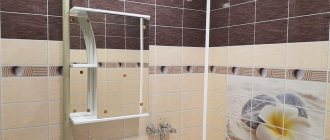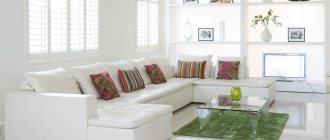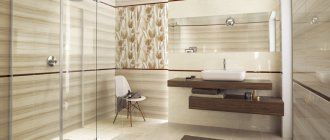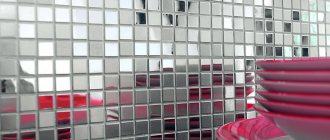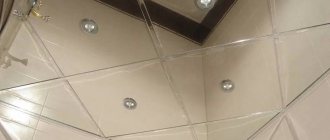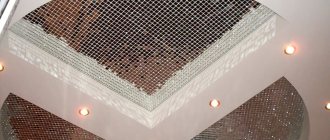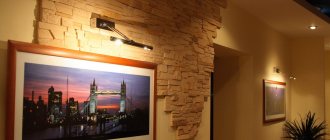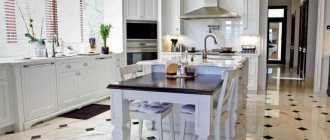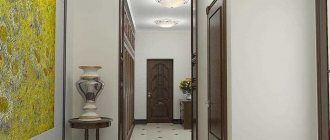11/22/2020 Read in 7 minutes.
In our new article you will learn how you can decorate your bathroom and kitchen with marbled tiles and porcelain stoneware. We present to you the best examples from the portfolio of the Fundament Group of Companies in recent years, which will show the possibilities of fashionable design solutions.
Features of marble tiles
Marble finishing has been used to decorate residential premises since ancient times. During excavations in Greece, Italy and Mesopotamia, remains of marble structures were found, so the durability of this material is beyond any doubt.
Natural stone can enhance the design of any room. Artificial imitation is of high quality and reasonable price.
Marble tiles are used for the bathroom, living room, hallway, finishing loggias, balconies and stairs.
This design looks especially impressive in spacious rooms. The biggest plus of this design is that it never goes out of style.
Type of tiles for the apartment
For interior decoration of apartments, manufacturers offer coatings with imitation marble of various types. In stores you can find tiles:
- floor;
- wall;
- decorative;
- mosaic
Each type differs in performance characteristics and has its own characteristics. But the plus is that manufacturers produce entire collections, which include tiles of different types and sizes. Thanks to this, there are no difficulties in combining floor and wall tiles. If both are from the same collection, then they fit perfectly.
Floor
It has increased wear resistance and can withstand any load. The floor covering is not afraid of impacts and is practically not scratched if used correctly. It is widely used for decoration of residential and non-residential premises.
The selection of floor tiles is huge. You can equally easily find snow-white porcelain tiles for a classic living room in a private house, and dark ones for a bathroom in a standard apartment. As an alternative, today they use quartz vinyl tiles, which are made from polyvinyl chloride and quartz sand.
Wall-mounted
Manufacturers offer a huge selection of beautiful wall tiles inspired by wood, leather, natural stone, plaster and other surfaces. If earlier this material was used only for finishing bathrooms and kitchens, today the boundaries of its use have expanded.
Thus, tiles that imitate marble can now appear in the interior of a bedroom, living room, or hallway. The main thing is to choose the right finishing material according to its performance characteristics. For the kitchen, buy one that is not afraid of heat and cleaning chemicals. For the bathroom you need moisture-resistant tiles. To make the interior stylish, do not be afraid to combine light and black tiles, plain and with veins. You can choose a seamless masonry option, you can leave contrasting seams and divide the wall with a border with a pattern.
Decorative
This tile consists of two parts: background and decorative elements - panels, borders, interesting inserts. Before buying such a tile, consider how it looks in the photo. If the decorative part is too large, it will not be suitable for a small apartment.
For a spacious room, you can choose decorative marble floor tiles with a round or square panel in the center. This option, with only a smaller area, is also suitable for the bathroom. But decorative tiles are often made from gypsum, which is susceptible to moisture, so not all types are suitable for bathrooms.
Mosaic
It will decorate a room of any size. In large rooms, mosaics are placed on the floor, in small kitchens - on the entire wall or part of it. Tiles can be square, rectangular or hexagonal. Each of them has a special shade and its own pattern.
In Provence style interiors, dark brown and beige tiles are often combined, and in classic ones - white, red, black. If you want the interior to look rich, choose mosaics with gold, copper or silver specks. Blue, blue, yellow and light gray tiles are suitable for a Mediterranean interior. Even a small mosaic panel will become the center of the interior.
Glossy tiles
A glossy surface is obtained by polishing natural marble. Such tiles have a pronounced shine and excellent reflective qualities. These properties allow it to be widely used in design.
Glossy tiles look very impressive. It gives the impression of an expensive material due to its reflective ability.
The only disadvantage of glossy surfaces is that when water gets in they become very slippery. That is why such a coating is very rarely used for floor finishing.
Choosing tiles for the interior of an apartment
The marble coating also differs in texture. It happens:
- matte;
- glossy;
- semi-gloss.
The first will absorb light, and the second and third will reflect, like a mirror. Take this nuance into account when choosing a finishing material.
Matte
Such a surface does not reflect light, so stains, dust and dirt are not visible on it. Such tiles need to be washed less often than glossy ones. And small scratches are not visible on it. The matte surface does not slip, so this type of material is suitable for bathrooms and hallways.
But there are also disadvantages. If the surface is too porous, it is difficult to clean and some stains cannot be removed. It also absorbs light, making the room visually smaller. You should not lay such tiles in dark, narrow rooms.
Glossy
This surface requires more careful maintenance, because any stains and splashes are visible on it. It makes any room bright and elegant, and most importantly, visually expands it. If you want to make a small bathroom seem larger, add more glossy surfaces to the interior. These tiles are easy to clean and do not require the use of abrasive cleaning agents. A significant drawback of the glazed surface is that it is very slippery.
Atlas Concorde Marvel Pro
Semi-gloss
This is the golden mean that many choose. This material has a low shine and moderately reflects light. It is equally suitable for decorating walls and floors. The semi-gloss surface looks noble and aesthetically pleasing.
Matte products
After polishing the stone, a rough surface is obtained. This method deprives the material of its shine, but allows you to obtain a safe, non-slippery coating suitable for laying on the floor.
Typically, matte tiles have calm shades, so they are very popular among designers. This material is also made from natural stone.
Video description
Video tutorial on cleaning stains from marble:
Bathroom
Natural stone marble is used for cladding wall surfaces and as flooring. Due to the velvety texture and glossy shine of polished marble, a refined, noble atmosphere is created in the room, and the color tints of delicate pastel tones visually expand the boundaries of the room.
Marble and mosaic Source tildacdn.com
Typically, one type of marble stone is used to decorate a bathroom. In this case, to dilute the boring monotony, various methods of laying stone on the walls are used: marble slabs are laid using the French herringbone method in the form of a mosaic covering, or simply change the directions of the pattern and design of the tiles.
The relief surface of the wall dilutes the monotony Source agoda.net
The latest fashion trends in creating stylish interiors allow deviations from generally accepted canons and suggest using marble stones that match the tone in the decoration of bathrooms, for example, the walls are finished with beige marble with brown veins, and the flooring is made of marble in brown tones.
Combination of marble in a bathroom interior Source deezme.ru/
From a practical point of view, the best choice for cladding bathroom walls would be white marble or a light gray shade - traces of moisture droplets are not visible on such a surface, which means there is no need to constantly clean the walls.
To fully reveal the natural beauty of the marble coating, designers recommend finishing the entire bathroom wall, preferably the front wall, with marble.
Marble wall Source www.catalina.ru
Marbled tiles
The latest developments make it possible to obtain a beautiful imitation with a “natural” marble pattern. Such products look very impressive in the interior - marble tiles are used for flooring
Note!
Mosaic tiles: TOP-120 photos and videos of mosaic tile design ideas for kitchens and bathrooms. Pros and cons of mosaics, types and materials
- Tile for backsplash: varieties of tile materials, colors and patterns. Methods for laying tiles on an apron (photo + video)
Tiles for the stove - TOP-150 photos and videos of design ideas for tiles for the stove. Requirements and features of tiles, criteria for choosing a suitable material
The material is undemanding in maintenance and easy to install, and its affordable cost makes it very popular on the market.
Interior design of a bathroom in porcelain stoneware: 5 photos
view album in new window
In the photo: Bathroom design with a shower niche and combined finishes
Below you will see several examples of renovation and design projects of bathrooms from our designers from the Fundament Group of Companies. Let's see!
Dark bathroom with marble and chocolate agate finishes
view album in new window
In the photo: Dark interior of a combined bathroom
An unusual combination in decoration: several types of marble and imitation semi-precious agate for the accent area in the shower.
Futuristic bathroom design project with chic
view album in new window
In the photo: Design project for a combined bathroom in 2022
Fashionable and very modern bathroom interior with double wall-hung sink for couples. There is enough space underneath for a comfortable approach to the furniture. The mirror has an enlarged format and integrated neon lighting lines.
Cozy family bathroom in soft colors
view album in new window
In the photo: Small bathroom in delicate shades
A modest and cozy bathroom in light marble and with a custom-made stone countertop. Note the rounded corners and built-in sink.
Designer bathroom renovation in white and stone shades
view album in new window
In the photo: Interior with patterned porcelain tiles
A stunning example of using geometric pattern tiles in a small space. Pay attention to the strictly verified color scheme of the interior!
Marblelite
This material appeared on the construction market relatively recently.
It is obtained by applying marble dust to a non-woven surface. The result is quite flexible products with a thickness of 2-3 mm. They are easily cut into the required parts using scissors or a knife and are suitable for finishing any surface without leaving a large amount of dust and waste.
After laying marble tiles, a smooth, seamless surface is obtained.
What types are there?
Marble in the interior can be real or simulated. Let's consider the features of each type, the pros and cons of use.
Natural marble
Natural marble is produced in the format of plates, slabs, slabs of various sizes, as well as marble chips. By mixing it with polyester resin you can get a strong tabletop for any purpose. Flexible stone deserves special attention: a modern finishing material that is a thin slice of stone glued to a flexible base.
Another production option is in the form of ready-to-use products: marble countertops, wall and floor tiles, mosaics, sinks. The advantages of natural materials include:
- strength and durability (service life more than 100 years);
- hygiene (bacteria, fungi, mold do not live on the surface);
- resistance to high temperatures;
- beautiful appearance.
Among the disadvantages, in addition to the high cost, is the complexity of processing. It is almost impossible to make a product from this stone yourself.
Imitation marble
Imitation stone is available in completely different formats and materials. General advantages of “counterfeits”:
- Various colors. In addition to natural natural tones, it can be quite unusual: pink, burgundy, blue.
- Ease of processing. PVC is cut with a regular knife, tiles are cut with a special one - but even this can be laid on the walls or floor with your own hands.
- Profitable price. Any material that imitates texture is cheaper than the original. Therefore, the decision to add marble to the interior will not be expensive.
Dimensions and shape of products
Depending on the manufacturer and the characteristics of the material, the sizes of marble tiles can vary significantly.
Products with a ceramic base can be square or rectangular. The dimensions are usually small: 20x20, 20x30 cm.
As for lithoceramics, it mainly has standard sizes - from 61x61 cm to 30.5x30.5 cm. Manufacturers produce square and rectangular tiles.
Marblestone is cut into pieces of any shape and size depending on needs.
Products made from natural materials can differ in impressive dimensions, but standard sizes are more common (30 x 60 and 30.5 x 30.5 cm), which are more convenient to install.
In what style can it be used?
Initially, marble was considered an element exclusively of palace styles: baroque, art deco, classic.
Today it has found its place in minimalism, advanced high-tech and even oriental wabi-sabi.
But you can find marble details anywhere. Designs in neoclassical, scandi, modern, loft styles often include marble floors, bathroom walls or countertops.
Universal shades
White marble tiles often become the basis for a mono interior. Designers receive a light, airy interior, which is easily diluted with bright details and decor.
White will be an excellent contrasting addition to black wall decoration. Glossy surfaces look especially impressive.
Beige tones are perfect for the kitchen, bathroom or toilet, as well as any room in a classic style.
Floor finishing is often done using brown tiles with golden veins. The design is complemented by elegant, graceful decor.
Marble in the living room interior: design ideas
view album in new window
In the photo: Coffee table with marble top
In the design of the living room, marble is used everywhere: for the tops of coffee tables and cabinets, in the decoration of floors and walls, for the design of stairs and steps, window sills and in decor!
Classic peach and gold living room with a French feel
view album in new window
In the photo: Interior of a finished living room renovation in classicism style
This turnkey apartment renovation option is perfect for anyone who loves the French classicism style in interior design.
Luxurious design of a living room with a kitchen in a niche with gold accents
view album in new window
In the photo: Kitchen-living room renovation in warm chocolate and gold colors
A luxury option with an open-plan kitchen-living room and panoramic views is a renovation from the Fundament group of apartments in the Dolina Setun residential complex. The total area of the apartment is 133 square meters.
Kitchen-living room with a beautiful formal dining room and geometric ceiling
view album in new window
In the photo: Design of a dining room in a living room with luxury finishing
Another three-room apartment in the Setun Valley residential complex, renovated in the Art Deco style from the Fundament Group of Companies! It looks simply great!
Elite living room renovation in shades of gray with complex combined finishing
view album in new window
In the photo: Fashionable living room interior with a formal dining area
In the photo above you see a fashionable interior in the Art Deco style with a complex combination of tiles, marble, mirrors, moldings, with built-in lighting and geometric elements.
Modern living room with fireplace portal and ultramarine curtains
view album in new window
In the photo: Interior of a small living room with designer renovation
A wonderful example of a laconic finish in a modern style for a living room in a new building!
Chic living room in Art Deco style in blue and beige tones
view album in new window
In the photo: An example of a living room design project in cold colors
Here, marble finishing was used for the fireplace portal in blue, which echoes the shades of the upholstery of the sofa group.
Bright colors
Rich shades of red may be appropriate in large rooms: the living room of a country house, the fireplace room. Spectacular “aged” surfaces are reminiscent of the decoration of a medieval castle.
The combination of green and blue, inherent in Baroque and Rococo, looks original in the interior. A luxurious design with malachite or turquoise walls is a win-win option for decorating a bathroom or living room combined with a dining room.
What does marble go with?
When creating a design that will last forever, combine marble with wood: this duo will never go out of style.
In the bathrooms, the symbiosis with small glass mosaics looks original.
Variations of gray marble in the interior create harmonious combinations with metal: chrome-plated sanitary ware or gold decor will make the stone sparkle in a new way.
The industrial style offers an original symbiosis with concrete, and so that the pair does not seem too cold, it is diluted with wood.
The photo shows a combination of black stone with wood and concrete
Photo of marble tiles
Color combinations of marble elements
Decorators try to highlight gray, white and colored marble in the interior. And the main difference is not only in the color itself, but also in the area of use, in the processing methods. White marble is unusually fragile and is not suitable for outdoor use; there it is used in exceptional cases.
In addition to mechanical disturbances, negative effects due to weather conditions can be detected. This manifests itself in yellowness and coloration.
Gray marble is mechanically more stable and relatively easy to work with. This material practically does not suffer from time, so it can confidently decorate both the inside of the room and the facade.
Colored marble is approximately the same in practical qualities as gray marble, but aesthetically it is much more pleasant, and therefore is more valuable. There are many colors in such a mineral, and sometimes they choose not even a specific color, but veins of a characteristic type that run through the stone in different places. Colored marble, like gray, is equally applicable in interior and exterior decoration.
It is worth considering that in any case it is still a “delicate” stone. The resulting products and coatings may not be able to withstand even normal operating conditions. Of course, marble window sills, countertops and even stairs look good. However, they are less durable than their granite counterparts.
Therefore, in most cases, all the same critical areas are faced with granite, and marble is used inside buildings.
According to experienced designers, marble must be combined with warm materials. This material is good in moderate options and designs, especially when it comes to private homes. Too much marble and surfaces can make a room seem too cold and no longer feel like a cozy home.
The type of polished material is sensitive to light: its inept selection, instead of revealing its advantages, emphasizes its shortcomings.
White and gray stone look good in modern interiors, and slabs are ideal for bathrooms.
Marble sink
marble sink - regardless of color and shape - will always be an exquisite decoration of the entire room. It can have a completely minimalist shape and be beautiful in its simplicity.
However, if you are looking for something unique, something that attracts attention, it would be good to try a washbasin model whose function will be taken over by the background, because it will first of all represent a fantastic decoration.
What original marble sinks can be found in stores?
- Washbasins in shades of white, grey, blue and green,
- Washbasins inspired by nature - in the shape of a shell or a drop,
- Bowl-shaped marble washbasins
- Cylindrical and pedestal sinks,
- A washbasin whose design remains raw and unpolished.
Cast marble bathtub
A durable and stylish bathtub is the centerpiece of any elegant bathroom or bathtub. For many people, the pinnacle of luxury in the bathroom style category is the marble bathtub , associated with palaces and other luxurious interiors. When choosing a bathtub made of this material, you can be sure of its proven strength - much greater than, for example, ceramics.
Cast marble is a timeless material that, unlike ceramic materials, allows for a wide variety of shapes. It allows the production of shapes that would be unimaginable using conventional ceramics. Thus, marble baths have perfectly clean edges and perfectly smooth space inside.
The final surface finish consists of a layer of colored resin (gelcoat) that protects the cast marble from scratches as well as commonly used cosmetics and hygiene products.
